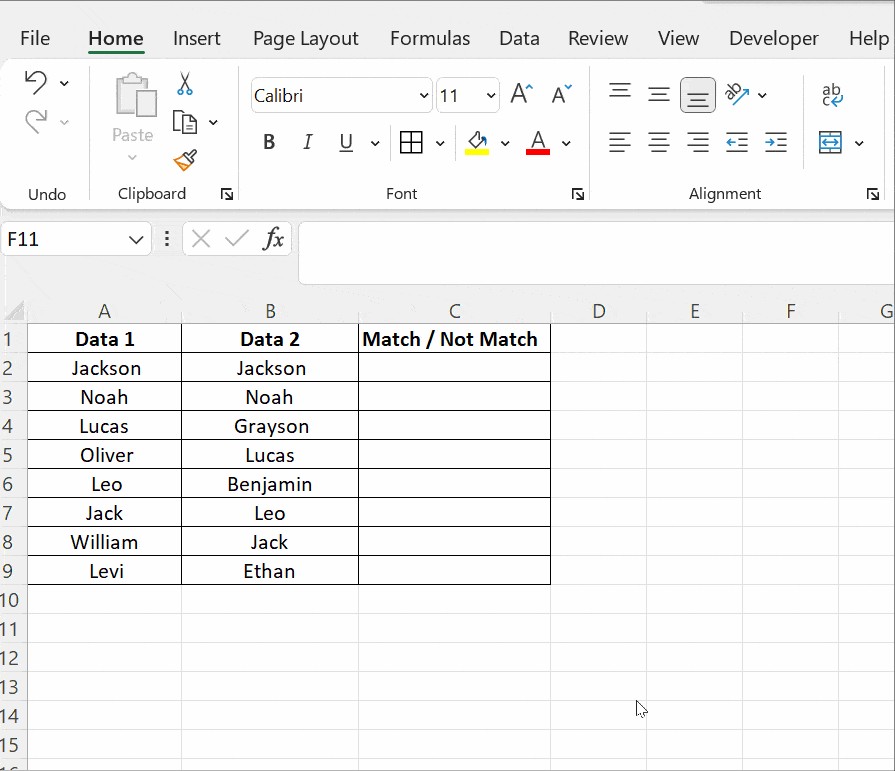Comparing two columns in Excel is a common task, yet it can be challenging without the right techniques. At COMPARE.EDU.VN, we provide a streamlined approach to efficiently compare columns in Excel, empowering you to unlock hidden patterns within your data. Discover practical methods, from utilizing built-in functions to employing conditional formatting, and simplify your data analysis workflow with Excel comparison tools.
1. Understanding the Importance of Comparing Columns in Excel
Excel is an indispensable tool for data storage, manipulation, and informed decision-making. Data analysts rely heavily on Excel to gather information vital for marketing and sales strategies. In large spreadsheets, comparing two columns is a critical task to ensure data accuracy and completeness.
Manually comparing columns can be time-consuming and prone to errors. Efficiently comparing columns helps in:
- Identifying missing data
- Highlighting matching or mismatching data
- Ensuring data integrity across linked spreadsheets
2. Methods to Compare Two Columns in Excel
Depending on your specific needs, several methods can be used to compare two columns in Excel. Here’s a breakdown of the most effective approaches:
- Highlighting unique or duplicate values using built-in functions
- Conditional formatting to visually represent differences
- Row-by-row comparison using formulas
- Leveraging LOOKUP formulas for more complex comparisons
3. Comparing Two Columns with the Equals Operator
A simple and direct method is using the equals operator (=) for a row-by-row comparison. This method returns “TRUE” if the values in the compared rows are the same and “FALSE” if they differ.
3.1. Step-by-Step Guide
- In cell C2, enter the formula
=A2=B2and press Enter. - Drag the fill handle (the small square at the bottom-right of the cell) down to apply the formula to the rest of the rows.
- Column C will now display “TRUE” for matching rows and “FALSE” for mismatching rows.
This method provides a quick overview of matching and mismatching data but may require further analysis for larger datasets.
4. Using the IF Condition for Enhanced Comparison
The IF condition enhances the comparison by providing custom messages like “Match” or “Not Match” instead of TRUE/FALSE values.
4.1. Identifying Matching Values
The formula =IF(A2=B2,"Match","") returns “Match” for rows with matching values and leaves the cell blank for others.
4.2. Identifying Mismatching Values
To specifically identify mismatches, use the formula =IF(A2=B2,"Match","Not a Match"). This displays “Match” for identical rows and “Not a Match” for dissimilar ones.
4.3. Highlighting Differences
To highlight differences, replace the equals sign with the non-equality sign (<>): =IF(A2<>B2,"Match","Not a Match"). This formula identifies rows where the values differ.
5. Case-Sensitive Comparison with the EXACT() Function
The EXACT() function provides a case-sensitive comparison, distinguishing between “Text” and “text”.
5.1. Understanding the EXACT() Function
The syntax is =EXACT(text1, text2). It returns TRUE if the text strings are identical (including case) and FALSE otherwise.
5.2. Applying EXACT() with IF
Combine EXACT() with the IF condition for practical use: =IF(EXACT(A2, B2), "Match", "Mismatch"). This ensures that only rows with identical case are marked as “Match”.
For example, if A2 contains “Nova Scotia” and B2 contains “nova scotia”, the EXACT() function will return FALSE, and the IF condition will display “Mismatch”.
Alt Text: Demonstrating case sensitive column comparison using the EXACT function in Excel, displaying a mismatch between “Nova Scotia” and “nova scotia”
6. Conditional Formatting for Visual Comparison
Conditional formatting allows you to visually highlight matching or unique values directly within the columns.
6.1. Highlighting Duplicate Values
- Select both columns.
- Go to Home → Styles → Conditional Formatting → Highlight Cell Rules → Duplicate Values.
- Choose a formatting style (e.g., fill color) and click OK.
This highlights all duplicate values in both columns, making it easy to spot common entries.
6.2. Highlighting Unique Values
- Select both columns.
- Go to Home → Styles → Conditional Formatting → Highlight Cell Rules → Duplicate Values.
- In the dialog box, choose Unique from the dropdown menu.
- Choose a formatting style and click OK.
This highlights values that appear only once across both columns.
6.3. Clearing Conditional Formatting
To remove the applied formatting, go to Conditional Formatting → Clear Rules → Clear Rules from Selected Cells.
Alt Text: Configuring conditional formatting rules in Excel to highlight duplicate values between two columns
7. Leveraging Lookup Functions for Advanced Comparisons
Lookup functions, such as VLOOKUP, HLOOKUP, and XLOOKUP, are powerful tools for comparing data across columns or tables.
7.1. Understanding VLOOKUP
VLOOKUP (Vertical Lookup) searches for a value in the first column of a range and returns a value from a specified column in the same row.
7.2. Using VLOOKUP to Compare Columns
Suppose column A contains a list of items, and column B contains another list. To check if each item in column A exists in column B:
- In cell C2, enter the formula
=VLOOKUP(A2, $B$2:$B$5, 1, FALSE). - Drag the formula down to apply it to the rest of the rows in column A.
A2is the lookup value (the item from column A).$B$2:$B$5is the table array (the range of cells in column B to search within). The dollar signs create an absolute reference, ensuring the range doesn’t change when dragging the formula.1is the column index number (the column from which to return a value). Since we are looking up in column B itself, it’s 1.FALSEspecifies an exact match.
The result will show the value if found, or #N/A if not found.
Alt Text: Demonstrating how to compare two columns in Excel for missing data using the VLOOKUP function
8. Alternatives to VLOOKUP: INDEX-MATCH Function
The INDEX-MATCH function is a flexible alternative to VLOOKUP, especially when dealing with complex comparisons or when the lookup column is not the first column in the range.
8.1. Understanding INDEX and MATCH
INDEXreturns a value from a specified row and column within a range.MATCHreturns the position of a value in a range.
8.2. Using INDEX-MATCH for Column Comparison
Assume column A has IDs and column B has names, and you want to compare column D (IDs) with column A and return the corresponding name from column B.
- In cell E2, enter the formula
=INDEX($B$2:$B$4, MATCH(D2, $A$2:$A$4, 0)). - Drag the formula down to apply it to the rest of the rows in column D.
INDEX($B$2:$B$4, ...)returns a value from the range B2:B4.MATCH(D2, $A$2:$A$4, 0)finds the position of the value in D2 within the range A2:A4.0specifies an exact match.
This formula will return the name corresponding to the ID if found, or #N/A if not found.
9. Combining IF with AND/OR Conditions
For more complex comparisons involving multiple criteria, you can combine IF with AND or OR conditions.
9.1. Using AND for Multiple Matches
To find rows where all cells in multiple columns match, use the AND function: =IF(AND(A2=B2, A2=C2), "Full match", ""). This returns “Full match” only if A2, B2, and C2 are identical.
9.2. Using OR for Any Match
To find rows where any two cells match, use the OR function: =IF(OR(A2=B2, B2=C2, A2=C2), "Match", ""). This returns “Match” if any two of the cells A2, B2, or C2 are the same.
10. Real-World Applications of Column Comparison
Comparing columns in Excel is useful in numerous scenarios, including:
- Data Cleaning: Identifying and correcting inconsistencies in datasets.
- Inventory Management: Comparing stock levels across different locations.
- Customer Relationship Management (CRM): Identifying duplicate customer entries.
- Financial Analysis: Comparing financial data from different periods.
- Academic Research: Comparing survey responses or experimental data.
11. Advanced Techniques and Tips
To enhance your column comparison skills, consider the following advanced techniques:
- Using array formulas: For performing complex calculations across entire columns.
- Combining multiple functions: To create custom comparison formulas tailored to your specific needs.
- Using VBA (Visual Basic for Applications): To automate repetitive comparison tasks.
12. Common Mistakes to Avoid
When comparing columns in Excel, avoid these common mistakes:
- Incorrect cell references: Ensure that your formulas reference the correct cells and ranges.
- Case sensitivity issues: Use the EXACT() function when case matters.
- Ignoring data types: Ensure that the data types being compared are consistent (e.g., text vs. numbers).
- Not using absolute references: Use absolute references ($) to prevent ranges from changing when dragging formulas.
13. Optimizing Performance for Large Datasets
Comparing large datasets can be resource-intensive. Optimize performance by:
- Using efficient formulas: Avoid complex formulas that slow down calculations.
- Sorting data: Sorting data before comparison can improve the speed of lookup functions.
- Using helper columns: Create helper columns to perform intermediate calculations.
- Disabling automatic calculations: Temporarily disable automatic calculations to speed up processing.
14. Comparing Columns in Different Sheets or Workbooks
Excel allows you to compare columns across different sheets or even different workbooks.
14.1. Referencing Cells in Different Sheets
To reference a cell in another sheet, use the syntax SheetName!CellReference (e.g., Sheet2!A2).
14.2. Referencing Cells in Different Workbooks
To reference a cell in another workbook, use the syntax [WorkbookName]SheetName!CellReference (e.g., [Book2]Sheet1!A2). Ensure the other workbook is open.
14.3. Example
To compare cell A2 in Sheet1 of Book1 with cell A2 in Sheet1 of Book2, you could use the formula =IF([Book1]Sheet1!A2=[Book2]Sheet1!A2, "Match", "Mismatch") in a third workbook.
15. Utilizing Third-Party Add-Ins
Several third-party add-ins can simplify and enhance column comparison in Excel. These add-ins often provide advanced features such as fuzzy matching, data cleansing, and visual comparison tools.
15.1. Popular Add-Ins
- Ablebits Data Suite: Offers a range of data management and analysis tools, including advanced comparison features.
- ASAP Utilities: Provides a collection of useful tools for Excel, including options for comparing columns and identifying differences.
- Kutools for Excel: Includes a variety of functions and tools to simplify complex Excel tasks, including column comparison.
15.2. Evaluating Add-Ins
When choosing an add-in, consider factors such as:
- Features: Does the add-in offer the specific comparison features you need?
- Ease of Use: Is the add-in intuitive and easy to use?
- Compatibility: Is the add-in compatible with your version of Excel?
- Pricing: Does the add-in offer a free trial or a subscription model?
16. Addressing Common Comparison Challenges
Certain data characteristics can make column comparison more challenging. Here’s how to address some common issues:
- Inconsistent Data Entry: Use data validation rules to ensure consistent data entry.
- Leading or Trailing Spaces: Use the TRIM function to remove leading or trailing spaces from text values.
- Different Date Formats: Use the TEXT function to convert dates to a consistent format before comparing.
- Typos and Spelling Errors: Use spell-checking tools or fuzzy matching techniques to identify and correct errors.
17. Automating Column Comparison with VBA
For repetitive column comparison tasks, consider using VBA (Visual Basic for Applications) to automate the process.
17.1. Recording a Macro
You can record a macro to automate simple comparison tasks:
- Go to View → Macros → Record Macro.
- Perform the steps you want to automate (e.g., applying conditional formatting).
- Click Stop Recording.
17.2. Editing the VBA Code
You can then edit the VBA code to customize the macro:
- Go to View → Macros → View Macros.
- Select the macro and click Edit.
17.3. Example VBA Code
Here’s an example of VBA code to compare two columns and highlight differences:
Sub CompareColumns()
Dim LastRow As Long, i As Long
LastRow = Cells(Rows.Count, "A").End(xlUp).Row
For i = 2 To LastRow
If Cells(i, "A").Value <> Cells(i, "B").Value Then
Cells(i, "A").Interior.ColorIndex = 6 ' Yellow
Cells(i, "B").Interior.ColorIndex = 6 ' Yellow
End If
Next i
End SubThis code compares column A and column B, and highlights differing cells in yellow.
18. Practical Examples and Case Studies
To illustrate the practical application of column comparison techniques, let’s consider a few real-world examples:
18.1. Example 1: Comparing Sales Data
A sales manager wants to compare sales data from two different regions to identify top-performing products.
- Columns: Product Name, Region 1 Sales, Region 2 Sales
- Technique: Use conditional formatting to highlight products with significantly different sales figures in each region.
- Insight: Identify products that perform well in one region but not in another, and adjust marketing strategies accordingly.
18.2. Example 2: Identifying Duplicate Customer Records
A marketing team wants to identify duplicate customer records in their database.
- Columns: Customer ID, Name, Email, Phone Number
- Technique: Use the IF condition with AND to identify records with matching names, emails, and phone numbers.
- Insight: Merge duplicate records to improve data accuracy and reduce marketing costs.
18.3. Example 3: Comparing Inventory Levels
A warehouse manager wants to compare inventory levels across different warehouses.
- Columns: Product ID, Warehouse A Stock, Warehouse B Stock
- Technique: Use VLOOKUP to compare the stock levels of each product across the two warehouses.
- Insight: Identify products with low stock levels in one warehouse and transfer stock from another warehouse to meet demand.
19. Frequently Asked Questions (FAQs)
19.1. How do I compare two columns in Excel for exact matches?
Use the formula =IF(A2=B2, "Match", "Mismatch") for a simple comparison or =IF(EXACT(A2, B2), "Match", "Mismatch") for a case-sensitive comparison.
19.2. Can I compare two columns in different Excel files?
Yes, use the syntax =[WorkbookName]SheetName!CellReference to reference cells in another workbook. Ensure the other workbook is open.
19.3. How can I highlight differences between two columns?
Use conditional formatting with the “Unique” rule or the formula =IF(A2<>B2, "Different", "").
19.4. What is the best way to compare large datasets in Excel?
Optimize performance by using efficient formulas, sorting data, using helper columns, and disabling automatic calculations.
19.5. How can I compare two columns and return a value from another column?
Use the INDEX-MATCH function to look up values in one column and return corresponding values from another column.
19.6. Is there a way to compare two columns ignoring case?
Use the formula =IF(UPPER(A2)=UPPER(B2), "Match", "Mismatch") to convert both values to uppercase before comparing.
19.7. How do I find missing values in one column compared to another?
Use the VLOOKUP function to search for values in one column within another column. The #N/A result indicates a missing value.
19.8. Can I use VBA to automate column comparison?
Yes, use VBA to create macros that automate repetitive comparison tasks.
19.9. What are some common mistakes to avoid when comparing columns in Excel?
Avoid incorrect cell references, case sensitivity issues, ignoring data types, and not using absolute references.
19.10. Are there third-party add-ins that can help with column comparison?
Yes, popular add-ins include Ablebits Data Suite, ASAP Utilities, and Kutools for Excel.
20. Conclusion: Streamlining Data Analysis with Effective Column Comparison
Comparing two columns in Excel is a fundamental skill for data analysis. By mastering the techniques outlined in this guide, you can efficiently identify patterns, discrepancies, and insights within your data. From simple row-by-row comparisons to advanced lookup functions and VBA automation, Excel offers a range of tools to meet your specific needs. At COMPARE.EDU.VN, we empower you to make informed decisions and gain deeper insights from your data. Visit compare.edu.vn today to discover more resources and tools for data analysis and comparison. For further assistance, please contact us at 333 Comparison Plaza, Choice City, CA 90210, United States, Whatsapp: +1 (626) 555-9090.


